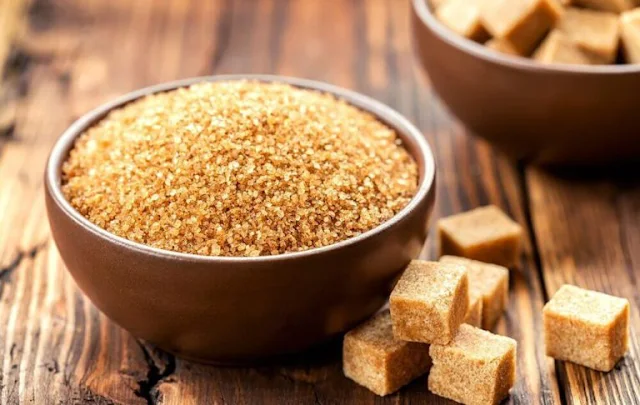For a number of reasons, brown sugar is more frequently used in baking than its white counterpart. Although the softer yet richer flavor is undoubtedly a bonus, the molasses concentration is what really sets this sugar apart. In addition to adding its unique hue, molasses is hygroscopic, which helps baked foods retain moisture and become more moist.
What are the benefits of brown sugar?
Although brown sugar is essentially the same as white sugar, its darker hue may make it appear more natural and healthful.
Since it keeps some of its minerals in molasses, it has a somewhat higher mineral concentration, but the difference is not significant enough to have an impact on benefits.
It differs from its white version primarily in that it has a richer flavor and can hold onto more moisture because of the molasses.
Similarly, molasses has been associated with certain health advantages, which also explains why this darker sugar is seen to be superior, although having too little of it to have any effect.
What is it made of?
The brownish varieties of sugar are made out of sugar cane. The juice of the latter is removed, boiled, and later centrifuged to separate the crystals, which contain molasses.
These crystals are then refined several times to remove its content in molasses until achieving the white table sugar everyone knows and is used to. The brownish varieties, however, are refined fewer times and retain part of its content in molasses, which gives them their distinctive color.
To put it simply, brown sugar is simply normal white sugar with molasses added to it.
The different varieties
Depending on the content of molasses, you can have more than one type of this darker sugar.
Light brown sugar: most commonly used for baking, due to its softer taste. It contains approximately 3.5% of molasses.
Dark brown sugar: contains on average 6.5% of molasses, which give it a stronger taste and color than the lighter variety.
Raw sugar: is less refined than the previous varieties, which is why it retains its natural brown color. The crystals are normally bigger, and its molasses content varies depending on the brand and producer. The most common varieties are the Turbinado, Muscovado and Demerara.
What is the difference between brown and white sugar?
Brown sugar is, in a way, incompletely purified sugar with a certain amount of molasses.Both sugars are extracted in the same way from the sugar cane or sugar beets and then filtered to separate the juice from the crystals. This needs to be done several times to be effective.
In the case of the brownish varieties, filtration stops when a certain amount of molasses is achieved. White sugar, on the other hand, is completely filtered to remove any traces of molasses and other juices, until a pure form or sucrose is obtained.
Are there side-effects?
The side-effects of the brownish varieties of sugar are just the same as those of the white kind. Both should be consumed in moderation as they can increase the risk of diabetes, obesity and yeast infections.
How to make brown sugar at home
To make brown sugar at home all you have to do it add one tablespoon of molasses for every cup of regular white sugar and stir until achieving the desired color and texture.
Bake some cookies
 |
| Source: Sally’s Baking Addiction |
Brown sugar is great to prepare cookies because it retains moisture better and gives them a fluffier texture. Its soft flavor also works to give it the extra something that makes them delicious.
Give it a try at the following recipe!
Ingredients
- 250g of all purpose flour;
- 250g of dark brown sugar;
- 170g of unsalted butter;
- 67g of granulated sugar;
- 1 large egg;
- 2 tsp of vanilla extract;
- 1 1/2 tsps cornstarch;
- 1 tsp of baking soda;
- 1/2 tsp ground cinnamon;
- 1/4 tsp of salt.
Directions
1. In a large bowl, combine the flour, cinnamon, baking soda, cornstarch and salt, and set aside.
2. Melt the butter and blend it with the dark sugar in another bowl. Make sure no lumps remain.
3. Whisk the egg and add in the vanilla extract.
4. Mix all the ingredients together in one single bowl. Use a large spoon to do it until you achieve a thick but soft dough.
5. Cover the dough and chill for 2h or up to 3 days.
6. Remove the dough from the refrigerator and let it warm naturally at room temperature for 10 minutes.
7. Preheat the oven to 325ºF/160ºC. Prepare two large baking sheets with baking paper.
8. Take 2 tablespoons of dough and roll them together until forming a tight ball. Pour the granulated sugar into a bowl or over a tray, and roll the dough over it.
9. Place the ball of dough on the baking sheets. Make sure to set them at least 3 inches apart.
10. Bake for 8 to 9 minutes, remove the baking sheets from the oven and use a spoon to flatten the top of the dough. Put them back in the oven for another 2 to 4 minutes.
11. Remove the cookies from the oven and set them aside for 10 minutes before transferring them to a cooling rack.

